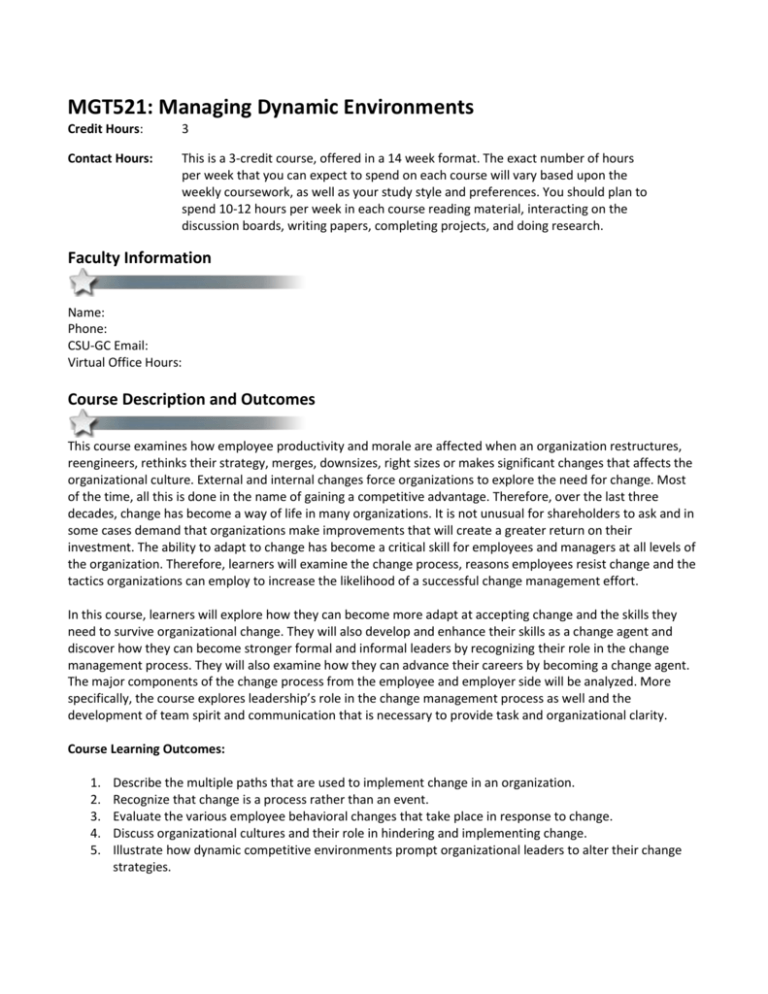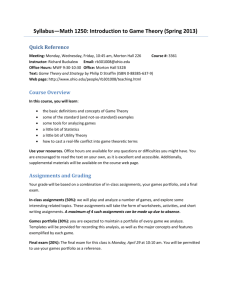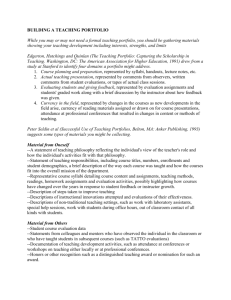MGT521_Student Course Syllabus
advertisement

MGT521: Managing Dynamic Environments Credit Hours: 3 Contact Hours: This is a 3-credit course, offered in a 14 week format. The exact number of hours per week that you can expect to spend on each course will vary based upon the weekly coursework, as well as your study style and preferences. You should plan to spend 10-12 hours per week in each course reading material, interacting on the discussion boards, writing papers, completing projects, and doing research. Faculty Information Name: Phone: CSU-GC Email: Virtual Office Hours: Course Description and Outcomes This course examines how employee productivity and morale are affected when an organization restructures, reengineers, rethinks their strategy, merges, downsizes, right sizes or makes significant changes that affects the organizational culture. External and internal changes force organizations to explore the need for change. Most of the time, all this is done in the name of gaining a competitive advantage. Therefore, over the last three decades, change has become a way of life in many organizations. It is not unusual for shareholders to ask and in some cases demand that organizations make improvements that will create a greater return on their investment. The ability to adapt to change has become a critical skill for employees and managers at all levels of the organization. Therefore, learners will examine the change process, reasons employees resist change and the tactics organizations can employ to increase the likelihood of a successful change management effort. In this course, learners will explore how they can become more adapt at accepting change and the skills they need to survive organizational change. They will also develop and enhance their skills as a change agent and discover how they can become stronger formal and informal leaders by recognizing their role in the change management process. They will also examine how they can advance their careers by becoming a change agent. The major components of the change process from the employee and employer side will be analyzed. More specifically, the course explores leadership’s role in the change management process as well and the development of team spirit and communication that is necessary to provide task and organizational clarity. Course Learning Outcomes: 1. 2. 3. 4. 5. Describe the multiple paths that are used to implement change in an organization. Recognize that change is a process rather than an event. Evaluate the various employee behavioral changes that take place in response to change. Discuss organizational cultures and their role in hindering and implementing change. Illustrate how dynamic competitive environments prompt organizational leaders to alter their change strategies. 6. Recognize that companies cannot always control the need for change, but they can proactively manage the change process. 7. Describe how to move an organization through the change process by creating dissatisfaction with the status quo. Participation & Attendance Prompt and consistent attendance in your online courses is essential for your success. If for some reason you would like to drop a course, please contact Saudi Electronic University. Online classes have deadlines, assignments, and participation requirements just like on-campus classes. Budget your time carefully and keep an open line of communication with your instructor. If you are having technical problems, problems with your assignments, or other problems that are impeding your progress, let your instructor know as soon as possible. Any assignment not completed within 7 days of the due date will not be graded and a score of zero (0) will be assigned. Course Materials Required: Spector, B. (2012). Implementing organizational change: Theory and practice (3rd ed.). Boston, MA: Pearson. ISBN-13: 9780132729840 Course Schedule Due Dates The Academic Week begins on Sunday and ends the following Saturday. All assignments are due by Saturday at midnight KSA time of the week assigned. Any assignment not completed within 7 days of the due date will not be graded and a score of zero (0) will be assigned. Discussion Activities: Application of knowledge is an important step in the learning experience and every course has key discussions wherein students can apply and analyze content as well as move toward synthesis. This course has Discussion Forums that provide learners an extended opportunity to interact with one another in an instructor-facilitated dialogue that focuses on key course themes. Students will apply and synthesize knowledge learned to case studies simulating real-world decisionmaking. Critical Thinking Application Assignments: each assignment will require students to apply their knowledge learned in the module to real-world scenarios. Week # 1 Readings Assignments Chapter 1 & 2 in Implementing Organizational Change PowerPoint Slides (located in course) Discussion Board (25) Chapter 3 in Implementing Organizational Change PowerPoint Slides (located in course) Critical Thinking (75) Chapter 4 in Implementing Organizational Change PowerPoint Slides (located in course) Bolognese, A. (2010). Employee resistance to organizational change. Retrieved from http://www.newfoundations.com/OrgTheory/Bolognese721.html Critical Thinking (75) Cumberland, D. & Herd, A. (Winter 2011). Organizational culture: Validating a five windows qualitative cultural assessment tool with a small franchise restaurant case study. Organization Development Journal, 29 (4), 9-20. Terranova, C. (2007). Assessing culture during an acquisition. Organization Development Journal, 25(2), 43-P48. Discussion Board (25) Levin, I., & Gottlieb, J. Z. (2009). Realigning organization culture for optimal performance: Six principles & eight practices. Organization Development Journal, 27(4), 31-46. Wriston, M. J. (2007). Creating a high-performance culture. Organization Development Journal, 25(1), 8-16. Critical Thinking (75) Chapter 5 in Implementing Organizational Change Min-Huei Chien. (2007). A study of human resource development and organizational change in taiwan. Journal of American Academy of Business, Cambridge, 11(1), 309-314. Critical Thinking (75) PowerPoint Slides (located in course) Discussion Board (25) Chapter 6 in Implementing Organizational Change Discussion Board (25) PowerPoint Slides (located in course) Maister, D. H. (2008). Why (most) training is useless. T + D, 62(5), 5356,58,6. Four ways to help employees adapt quickly to change. (2012). T + D, 66(6), 19-19. Critical Thinking (75) 2 3 4 5 6 7 8 9 10 Chapter 7 in Implementing Organizational Change Pledger, C. (2007). Building manager effectiveness by combining leadership training and organization development. Organization Development Journal, 25(2), 71-P76. Discussion Board (30) 11 12 PowerPoint Slides (located in course) Critical Thinking (75) Carter, E. (Spring 2008). Successful change requires more than change management. Journal for Quality & Participation, 31(1), p.20-23 Discussion Board (30) 13 14 None Discussion Board (40) PowerPoint Slides (located in course) Portfolio Assignment (350) Assignment Details This course includes the following assignments/projects: Week 2 Critical Thinking: Case Study (75 points) This assignment, along with the assignments in the following modules, will serve as a building block to your final portfolio paper, which is due in Module 14. Identify Lewin’s 3 stages of change implementation and explain the importance of each stage. (1-2 pages). Week 3 Critical Thinking: Case Study (75 points) Prepare a 4-6 page paper describing the essential tools/elements you would use to combat resistance organization change. Discuss the elements that you feel are essential in most situations and why. Week 5 Critical Thinking: Portfolio Proposal (75 points) Choose an organization at which you are currently working or one in which you are familiar. If neither is possible, conduct an internet search to identify an organization that has gone through a transformation process within the last 1-2 years. Be careful to pick one in which you can acquire sufficient information. Be sure to include the following information: a complete explanation as to why you’ve chosen the organization a brief summary of the organization Week 6 Critical Thinking: Case Study/Audit (75 points) Conduct an audit of the key insights to your chosen organization’s implementation strategy to determine the historical approach, the success rate, and the barriers faced in the change process. Prepare a 4-6 page paper that explains and analyzes your findings. Week 9 Critical Thinking: Matrix Structure (75 points) Identify/describe a matrix structure. How and when is this type of reporting structure best used? Provide specific examples of the pros and cons to a matrix structure. Prepare a 2-3 page paper that explains and analyzes your findings. Week 11 Critical Thinking: Strategy Formulation (75 points) Formulate strategies for the organization you have selected to overcome barriers and resistance to change. Prepare a 3-5 page paper following Saudi Electronic University academic writing standards. Week 14 Portfolio Assignment (350 points) Choose an organization at which you are currently working or one in which you are familiar. If neither is possible, conduct an internet search to identify an organization that has gone through a transformation process within the last 1-2 years. Be careful to pick one in which you can acquire sufficient information. Portfolio Project Outline: Description of organization and historical perspective regarding change. Identify triggering event. Describe diagnosis for change. Identify culture barrier, and other types of barriers and concerns. Define the stages of change and compare it to Lewin’s stages of change. Include information about the following: training, support systems, how new behaviors were reinforced, reward mechanisms, strategies to overcome barriers and resistance to change. Discuss what has been done to sustain the gain. Summary: What went well? What should have been done differently? Course Policies Course Grading 20% Discussion Participation 45% Critical Thinking Activities 35% Final Portfolio Paper Any assignment not completed within 7 days of the due date will not be graded and a score of zero (0) will be assigned.





